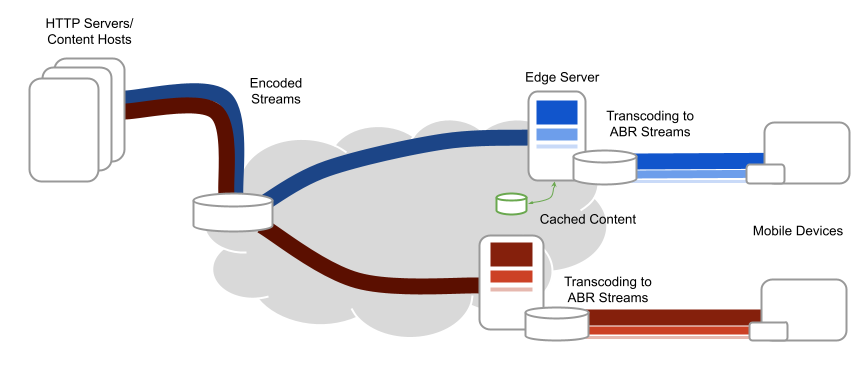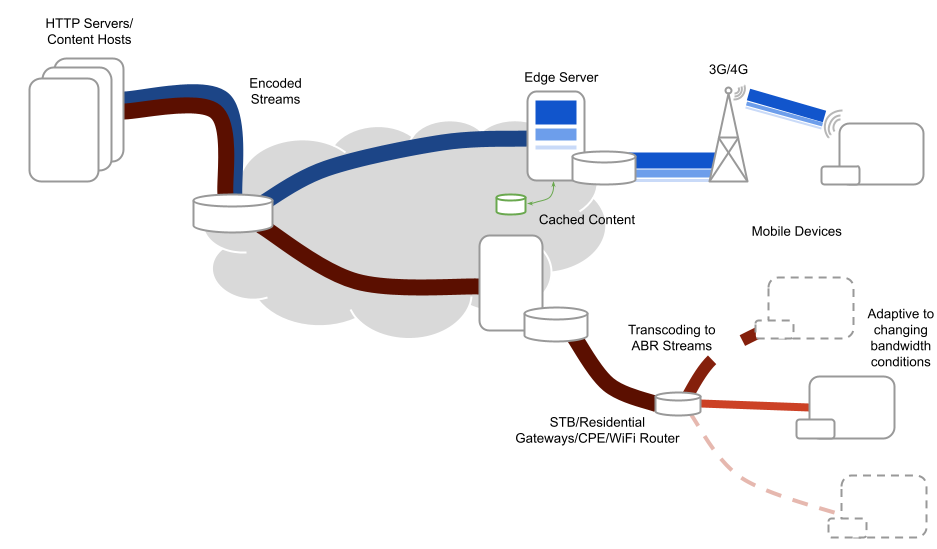Dear Reader,
Welcome back! My recent personal experience watching streaming video on my tablet device led me to study video streaming technologies and how they are silently providing a better quality of experience to content consumers.
Traditional broadcast viewing is increasingly being replaced with on demand, any-time, any-where, any-how viewing of the rich content that is available on the Internet. Service providers are now seeing video becoming the dominant data type flowing through their networks and there is even talk of your smartphone being the primary screen and your TV the secondary screen!! Imagine that.
Summarized below some of my views and research on adaptive streaming technologies and their impact on content creators, content distributors and content consumers.
Hope you find the information in this blog useful. Do let me know what you think in the comments section. Also, if you plan to use some/all of the information in the blog, please drop me a note.
Thx,
Jyothin
Welcome back! My recent personal experience watching streaming video on my tablet device led me to study video streaming technologies and how they are silently providing a better quality of experience to content consumers.
Traditional broadcast viewing is increasingly being replaced with on demand, any-time, any-where, any-how viewing of the rich content that is available on the Internet. Service providers are now seeing video becoming the dominant data type flowing through their networks and there is even talk of your smartphone being the primary screen and your TV the secondary screen!! Imagine that.
Summarized below some of my views and research on adaptive streaming technologies and their impact on content creators, content distributors and content consumers.
Hope you find the information in this blog useful. Do let me know what you think in the comments section. Also, if you plan to use some/all of the information in the blog, please drop me a note.
Thx,
Jyothin
Introduction
Adaptive Bitrate (ABR) Streaming based technologies are seeing increasing traction in online video streaming services as well as content hosting and delivery networks. Essentially, an ABR encoded stream allows one to seamlessly watch a video clip, streamed over the Internet, on any device without the usual nuances of caching, blocky video and stuttering. In addition, it allows a consumer to be mobile and continue watching the same video without any disruptions, while being mobile at the same time.
ABR technology has started gaining
popularity to circumvent issues in managing bandwidth. Typical video hosting sites have little control over the distribution path of the content in a network. Network service providers on the other hand typically have little control over the content that is being distributed over their networks. ABR allows a video service provider to overcome the issue of delivering video at optimum quality up to the last mile by encoding a single stream into multiple streams of varying bitrates and allowing the client to switch between these streams, seamlessly, depending upon the network bandwidth conditions and client device CPU usage.
popularity to circumvent issues in managing bandwidth. Typical video hosting sites have little control over the distribution path of the content in a network. Network service providers on the other hand typically have little control over the content that is being distributed over their networks. ABR allows a video service provider to overcome the issue of delivering video at optimum quality up to the last mile by encoding a single stream into multiple streams of varying bitrates and allowing the client to switch between these streams, seamlessly, depending upon the network bandwidth conditions and client device CPU usage.
Media Streaming Protocols
Traditional streaming methods have almost all of the time relied on UDP as the primary protocol of transmission of video packets. As video streaming became dominant in video communications and video networking, RTP/RTCP based streaming protocols also gained dominance. However, RTP/RTCP was still not sufficient to allow the kind of interactivity that OTT service providers would like to have to engage with consumers. Moreover, most Internet sites are HTTP based and allow for HTTP based progressive download of files. Building on the same web hosting technology, most ABR based streaming standards have been developed with HTTP as the underlying encapsulation mechanism.

Figure 1: Media Streaming Protocols

Figure 2-1: A simplistic media centric Content Delivery Network with source streaming.

Figure 2-2: A simplisctic media centric CDN with cached streaming and transcoding at the edge server.

Figure 2-3: A simplistic media entric CDN with ABR transcoding on a CPE device.
* For visual representation 3 ABR streams are shown.
Figure 1: Media Streaming Protocols
ABR based Standards*
Table 1: ABR standards
* As of Jan 2013
Figure 2-1: A simplistic media centric Content Delivery Network with source streaming.
Figure 2-2: A simplisctic media centric CDN with cached streaming and transcoding at the edge server.
Figure 2-3: A simplistic media entric CDN with ABR transcoding on a CPE device.
* For visual representation 3 ABR streams are shown.
HTTP Streaming and CDN
HTTP serves as the hosting and delivery mechanism for ABR encoded streams. In a typical CDN, HTTP servers can be located at the origin – also called host HTTP servers - or at an edge of a network – also called edge servers. Host servers have access to all the content as either a live AV stream or pre-recorded AV streams. Edge HTTP servers primarily serve that edge of a network that is geographically closest to the edge and cache content that is most widely access.
ABR compatible streams can be made available at the host server itself or at the edge server. At the host, the stream is encoded into multiple bit streams as required for the multitude of access devices as well as multitude of network bandwidth scenarios. This results in a single stream encoded into multiple streams of different resolutions, different bit rates and even different compression formats.
| Figure 3: PCRF (Policy Charging and Rules Function) based QoS and QoE restricts bandwidth usage based on user profile and service provider policy. * Bandwidth pipe sizes are only indicative |
What matters most to a client is the quality of experience (QoE) and quality of service (QoS) that a video hosting site and network service provider can guarantee. As more CDN networks are being deployed, caching content has typically been the solution to providing a good QoE to an end customer. Caching content in various formats, resolutions and bitrates is, in other words, a more feasible solution to a more challenging problem of changing network bandwidth conditions, client device CPU usage and customers' viewing patterns.
Network service providers on the other hand will not wait for video to continue to eat up all of their network capacity and PCRF based QoS and QoE are already widely used to monetize the growing share of streaming video in their networks.
A policy that allows premium subscribers access to a higher portion of the network capacity and free subscribers to a lower portion of the network capacity would help segmenting end users into appropriate user types based on individual usage patterns.
However, data, voice, and pure audio streaming are also data types that must not be ignored with the growth of 3G/4G based wireless networks.
Figure 3: Dynamic switching.
Table 2: Feature comparison with and without ABR from a client perspective.
Figure 4: ABR client side flow and HLS manifest file.
Conclusion
ABR is a silient technology that has entered into our living rooms and enhanced our viewing experience. We may not notice how and when ABR kicks in, especially when we see a change in the quality of video when watching a live event on our tablets or when the video suddenly becomes sharper and crisper.
For content creators, there shouldn't be much of a change in the way they create (or capture content). They could probably even get away with encoding the content in their favorite encoding format. Again, content creators could be at both ends of a media flow i.e. high end studios (for example) or an typical consumer recording events on their hand held device. One wouldn't expect either to use ABR technology.
Content distributors, on the other hand, would probably be the primary market segment that would adopt ABR technology. Both OTT service providers as well as network service providers would benefit from implementing ABR by the sheer fact that they would be able to provide a better QoE to consumers.
In markets where, ABR is still nascent and consumer are not willing to pay extra for a better QoE to service providers, niche consumers who can afford an ABR enabled CPE device for local in-house streaming for a better QoE - is the way to go.
Whether, we like it or not, ABR is seeing widespread deployment. What remains to be seen is how network service providers and OTT service providers will monetize this technology. My guess is it would eventually turn out to be another check mark in their marketing strategy with the cost of deploying ABR hidden in subscription fees.
For content creators, there shouldn't be much of a change in the way they create (or capture content). They could probably even get away with encoding the content in their favorite encoding format. Again, content creators could be at both ends of a media flow i.e. high end studios (for example) or an typical consumer recording events on their hand held device. One wouldn't expect either to use ABR technology.
Content distributors, on the other hand, would probably be the primary market segment that would adopt ABR technology. Both OTT service providers as well as network service providers would benefit from implementing ABR by the sheer fact that they would be able to provide a better QoE to consumers.
In markets where, ABR is still nascent and consumer are not willing to pay extra for a better QoE to service providers, niche consumers who can afford an ABR enabled CPE device for local in-house streaming for a better QoE - is the way to go.
Whether, we like it or not, ABR is seeing widespread deployment. What remains to be seen is how network service providers and OTT service providers will monetize this technology. My guess is it would eventually turn out to be another check mark in their marketing strategy with the cost of deploying ABR hidden in subscription fees.
References
nanoCDN could change live multi-screen economies, January 21, 2013. Multi-screen TV, News & Analysis, Videonet

